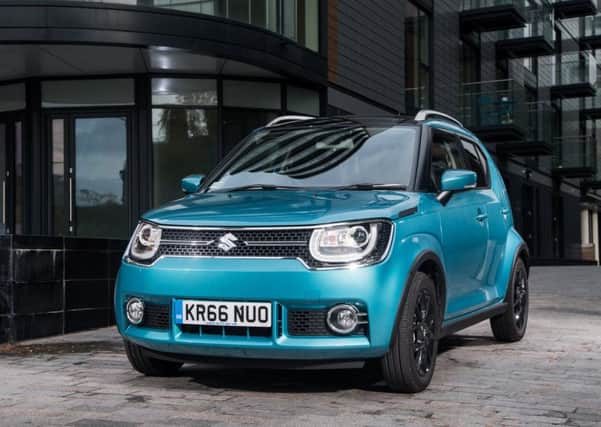Review: Suzuki Ignis


Its Baleno hatchback, from a little over £13,000, is a likeable value contender in the Fiesta group. The S-Cross SUV, relaunched last year meets the demand for a “lifestyle crossover” and the totally revamped Vitara attracted a new type of buyer. Its very popular Swift is replaced this year.
Then there’s the latest in Suzuki’s family history of small cars, the Ignis, which arrived at the end of 2016 to a warm reception from the motoring press.
Advertisement
Hide AdAdvertisement
Hide AdIt hasn’t got the prettiest name (it means fire in Latin) and first appeared at the turn of the century on another boxy Suzuki with baby 4x4 looks.
You can get one for a quid under £10,000 and the most expensive will cost you another £4,000. The template is a chunky four-door, 4/5 seater hatchback with a four-cylinder, 16-valve petrol engine producing 89bhp and 88bhp with a five-speed manual gearbox or a sequential five-speed automatic (from £12,299). Two models have a “mild” hybrid system, which doesn’t add to the official power ratings but does help with acceleration and, apart from a cold start, operates the starter motor. It recuperates energy when the car is slowing down. It adds a couple of miles a gallon to the official economy (70.6mpg) and drops the CO2 reading below the 100g road tax threshold.
That one costs £13,799 or, as tested here with Allgrip 4x4 traction, £13,999. The 4x4 reduces the economy (64.2mpg and 106g) but makes it the fastest sprinter with a 0-62mph time of 11.5 seconds. Note that if you want the top SZ5 trim you’ll have to buy one of the hybrids or an automatic.
So much for the paperwork. The Ignis stands out. It has a high face for the sector (Aygo, Adam, Twingo, Smart) and playful black cheeks at the edge of the bonnet. The wheel arches extend – giving the body a pinched look when viewed from the back. The roof pillars are decorated with diagonal indents. This all adds the cosmetic character which appeals to the target customers (the 21 to 35 age group – who can get a year’s free insurance if they take out a PCP hire purchase plan). Suzuki says the average dealer net profit is 59 per cent so you may have room to negotiate. No harm in asking.
What do you get? All but the SZ3 base model have sliding rear seats which maximise luggage space or rear leg room, but that model seats three in the back at a pinch. All have air conditioning, DAB audio and Bluetooth. The SZT (from £11,499) adds navigation, a rear camera, 16-inch alloys, roof rails, the wheel arch extensions (which resist road muck), two sliding rear seats and adjustment for the height of the driver’s seat.
The SZ5 (from £12,999 for the automatic) has camera activated emergency braking, powered rear windows, climate control, a leather wheel rim, cruise control LED headlights, daytime running lights and front fogs, lane departure warning and, on the 4x4 version, hill descent to control your downhill speed on slippery surfaces.
You’re probably thinking that the SZT is well enough equipped. The significant advantage of the model tested was its Allgrip traction – but only when you need that bad weather grip. I took it for a short drive and was enjoying it so much that I went on a 150-mile loop using main roads, motorway and hill and dale.
On bends the steering and balance felt perfect, in unison. The small four-cylinder engine has a sporty tune and an eager feel. Beyond 60mph it feels ready for a sixth gear, but five it is, and at 70mph the engine speed of 3000rpm is reasonably relaxed.
Advertisement
Hide AdAdvertisement
Hide AdIt was soon apparent that the bright cabin design (ivory coloured door panels and dash trim, polished metal door grips) gave it a light ambience, but light, per se, played reflective tricks in the central screen so that the information and navigation route was usually obscured. Nor did I like the small control tabs under the screen though, as an owner you’d hopefully get the hang of what does what.
However, the toggle switches for the heater system are perfect. The standard tyres are everyday 175/60/16 Bridgestone Ecopia – so if you are likely to be going into muddier or colder terrain you’ll consider fitting an appropriate tyre.
Driven briskly but within legal speed limits the trip meter recorded 53mpg. The quoted extra urban figure for this model is 70.6mph with 65.7 as a combined average, so it was shy of what an optimist may hope to get. The computer showed that in the previous 76 hours of driving the stop-start system’s stoppage time had been 80 minutes, saving, so it said, 609 miles in fuel.
Verdict: Likable small car. Well worth a drive.